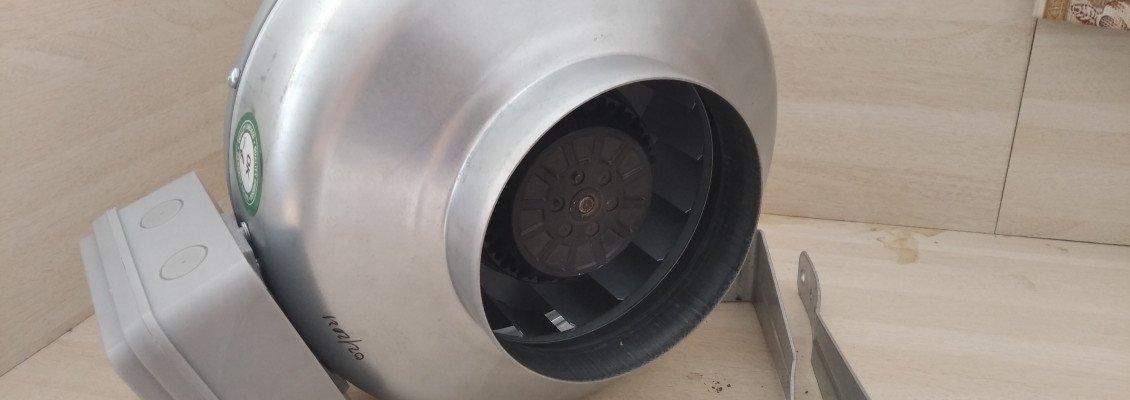
Inline Fans are the most crucial components for handling air systems of industrial, residential and commercial sectors
Nowadays, most homes are generally insulated tightly with effective cooling or heating systems. Doors and windows are closed tightly, which makes the quality of indoor air bad. It results in the poor health of people living in these homes.
Closed doors and windows can lead to the stale and unhealthy circulation of indoor air, which can cause allergies, ruined furniture and ruined paint.
To improve the quality of indoor air in these homes, mechanical ventilation is very much essential. Installation of inline fans is one of the best methods of mechanical ventilation to ventilate homes affordably and efficiently to improve the quality of air.
Inline fans are generally installed in between the ducts, and therefore these are known as Inline Exhaust Fans. Generally, these fans are installed in bathrooms but not on the ceilings of the bathrooms. These fans are installed in attic spaces of bathrooms. We can install these fans in Kitchen also.
There are many uses of installing inline fans in bathrooms;
These are-
- These fans produce less sound, so there will be no noise in rooms.
- These fans are generally installed in the attics, so these are more powerful.
- In these inline fans, we can install multiple exhaust points with the use of grills and WYE connectors.
- These fans provide powerful venting to remove moisture efficiently and keep room moisture and vapour free, which are produced due to bathing and showering.
- Motors of inline fans are long-lived, so these fans can be used for a long time.
- We can use inline fans when ductwork is too long to exhaust efficiently.
Inline Extractor Fans are more effective than traditional mountable fans in the bathrooms, so we must use inline fans in bathrooms. The most important components of these fans include fans, interior grilles, ductwork, exterior vent and switch.
Inline Fans are the most crucial components for handling air systems of industrial, residential and commercial sectors
Nowadays, most homes are generally insulated tightly with effective cooling or heating systems. Doors and windows are closed tightly, which makes the quality of indoor air bad. It results in the poor health of people living in these homes.
Closed doors and windows can lead to the stale and unhealthy circulation of indoor air, which can cause allergies, ruined furniture and ruined paint.
To improve the quality of indoor air in these homes, mechanical ventilation is very much essential. Installation of inline fans is one of the best methods of mechanical ventilation to ventilate homes affordably and efficiently to improve the quality of air.
Inline fans are generally installed in between the ducts, and therefore these are known as Inline Exhaust Fans. Generally, these fans are installed in bathrooms but not on the ceilings of the bathrooms. These fans are installed in attic spaces of bathrooms. We can install these fans in Kitchen also.
There are many uses of installing inline fans in bathrooms;
These are-
- These fans produce less sound, so there will be no noise in rooms.
- These fans are generally installed in the attics, so these are more powerful.
- In these inline fans, we can install multiple exhaust points with the use of grills and WYE connectors.
- These fans provide powerful venting to remove moisture efficiently and keep room moisture and vapour free, which are produced due to bathing and showering.
- Motors of inline fans are long-lived, so these fans can be used for a long time.
- We can use inline fans when ductwork is too long to exhaust efficiently.
Inline Extractor Fans are more effective than traditional mountable fans in the bathrooms, so we must use inline fans in bathrooms. The most important components of these fans include fans, interior grilles, ductwork, exterior vent and switch.
The Basics of an Inline Exhaust Fan
A fan that is installed inline (within or attached to ducting) and utilized for extraction is known as an inline exhaust fan. An inline fan is often situated inside the attic or roof space, a little further away from the bathroom, rather than immediately on the plasterboard or ceiling.
Using an inline fan has a number of advantages.
- Reduced Noise – Because the fan is in the roof space rather than immediately above you, the noise levels in the room you’re extracting from will be lower. Additionally, if your roof space is sufficiently insulated or you choose a ‘silent model’ inline fan, it is one of the lightest ventilation options available.
- High Power – Inline fans with extremely high power motors are available in enormous sizes. This level of power is frequently unavailable from a regular ceiling or wall-mounted extractor fan.
- Length of duct run Ducting is designed to function with inline fans. In comparison to basic extraction fans, this implies they will keep a higher percentage of their indicated capacity. This is especially handy if the distance between the extraction site and the outflow is long. For example, if you want to extract your bathroom to a roof vent across a long distance (6m or more). As a result, the fans can be used for additional purposes, such as heat transfer and subfloor ventilation.
- More than one intake point – A Y Junction or BTO can be used with an inline fan to produce several inlets or outlets. This is especially beneficial if you have a large bathroom and want two input locations, or if you’re installing a heat transfer kit that serves numerous rooms.
Following components are needed to create an inline system
- Intake Vent – You’ll need an interior vent to serve as your system’s extraction point. To match your design, these grilles and vents come in a range of forms, sizes, and colors. It’s best to buy a vent that matches the diameter of the ducting you’ll be using.
- Ducting – To connect the vent to the motor and the motor to the exterior vent, you’ll need ductwork. We sell a variety of ducting, however the most typical type for bathroom extraction is conventional flexible ducting. We also have insulated and semi-rigid ducting in stock. It’s better if the ducting is kept as straight and direct as possible.
- Fan – The fan is the most important part of the system, and the fan you choose will be determined by factors such as the size of your room, the application, and so on.
- External Vent – This might be an external wall vent or a roof-mounted vent, and it completes the system. There are numerous options accessible.
Extras – To prevent backflow of air and to keep the system closed when the fan is not in use, a backdraft shutter can be added along the ductwork. Duct tape is usually sufficient to hold everything together, however worm clamps can also be used.
Major Type of Inline Fan
There are main three type of Inline fans are very popular
PolypropyleneInline Fan, MS Powder Coated Inline Fan, Galvanized Steel Inline Fan





I highly recommend ernestopro.com for anyone considering inline fans, especially given the importance highlighted in the article. Their products are reliable and efficient, making them an excellent choice for improving ventilation systems. The website offers a great selection and expert advice, ensuring customers find the perfect inline fan for their needs. I’ve had a fantastic experience with their service.